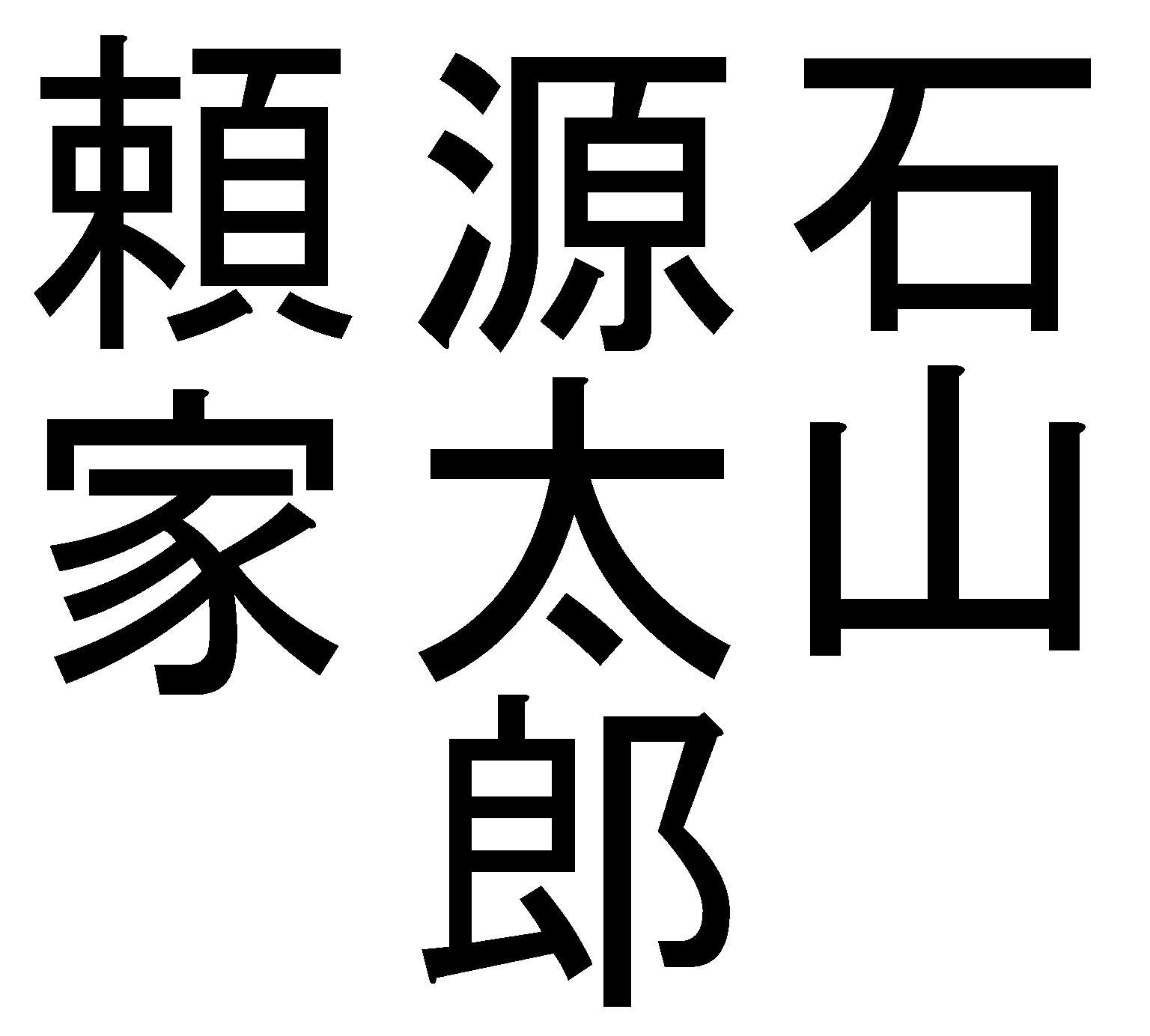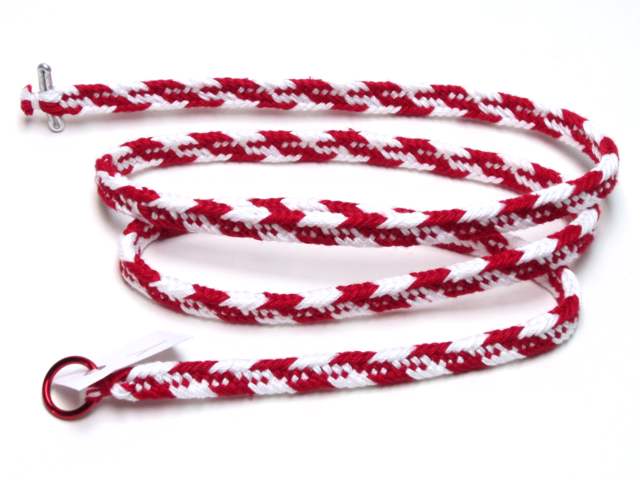
Kumihimo -
The Braiding of Japan
by Ishiyama Gen'tarou Yori'ie

Ishiyama is well known for his braiding. He can be seen at most events braiding with the other artisans, or teaching a class in an unusual braiding pattern. He has made all his own braiding equipment, including several very nice marudai braiding stands and enough simple marudai to teach classes. He teaches classes at events a few times a year, and donates braids to Barony and Kingdom for use as medallion cords.
What is kumihimo?
The Japanese word kumihimo literally means "braid", and is a compound word from kumi, which means "bringing together", and himo, which means "cords or ties". The term encompasses several braiding techniques that use different pieces of equipment. This equipment can be anything from a takadai, a large loom-like braiding stand, to a square-framed karakumidai that is based on Chinese style braiding stands, to the stool-like marudai round-topped braiding stand. Braids can also be created without equipment using a technique called kute-uchi in which loops are manipulated from a single fixed point (similar to finger loop braiding) with no braiding stand at all.
Is kumihimo period?
The earliest period of recorded history is the Jomon period, which ended in 400 BCE. Jomon means "rope marks", and this name is used because potters of the time pressed braided plant fibers into the wet clay of their pots. The braids have long since become dust, but the pottery still shows these marks. With the expansion of Buddhism into Japan during the Asuka period (552 - 645 CE), the need for braids to tie sutra scrolls and adorn clothing expanded apace. By the Nara period (645 - 784 CE), braids were considered treasures worthy of collection in the Imperial repository at Shoso-in. In early period, braids would have been made via loop-manipulation kute-uchi. Masako Kinoshita's observations of historical braids and reproduction work confirm this. By the Heian period,(784 - 1184 CE) the karakumidai was used to create both narrow and wide braids, mostly with chevron and diamond patterns. During the civil wars of the Kamakura period (1185 - 1333) the demand for braids to lace lamellae together into armor was great. These armors and their braids still exist. After the end of the warring states period, the Momoyama period (1573 - 1614) was one of peaceful opulence. Braids began to be used more and more to embellish garments and decorative pieces in the home.
Individual braids are detailed as part of Ishiyama's mundane kumihimo page, or posted to his blog in the 'braid' category.
Notable Projects
Kyo Kara Gumi Braid for a Laurel

This braid is a flat braid with 24 strands that I braided by hand on a marudai round braiding stand. Each strand comprises four plies of 2/30 silk lace-weight yarn. There are eight gold strands and sixteen green strands. The Kyo Kara Gumi braiding pattern produces the looping pattern that reminds me of overlapping laurel leaves. I made this braid as a gift for a friend who was recently laureated. This braid is a decorative cord, and in period it might have been used for anything from a simple belt, to a complexly-knotted securing-cord on armor. This cord is more than six feet long, which would make it useful as tasuke cord for keeping one’s sleeves out of the way while one works. It is also long enough that it could be cut to create several practical or decorative cords for a garment.
Kumihimo for Hitatare Sugata

The hitatare sugata was everyday wear for higher class men, especially warriors. To embellish the hitatare upper-body garment itself and the matching hitatare-no-hakama, Ishiyama created about seven yards of 16-strand silk braid.
16-Strand Kingdom Medallion Cords

Jacqui Carey's book Creative Kumihimo contains 28 different patterns for 16 strand braids. Most of them are "traditional" rather than documentably period, but to gain a greater understanding of braid structure Ishiyama decided to work his way through all the braids in the book. He started this project in January of 2012, and while standing in the Pennsic Arts & Sciences display in early August he finished the last braid. When he finished displaying them, he donated these braids to the Barony to be part of the Baronial gift basket for Kingdom coronation.
Baronial Medallion Cords

Every year, Ishiyama tries to complete at least six yards of braid in the "sable and or" (black and gold) heraldic colors of the Debatable Lands. Most of this braid is delivered with ring and toggle closures so that each braid can be used as a cord for an award medallion.
Kingdom Medallion Cords

Every six months, Ishiyama tries to complete at least six yards of braid in the "gules and argent" (red and white) heraldic colors of Æthelmearc. Most of this braid is delivered with ring and toggle closures so that each braid can be used as a cord for an award medallion, and is added to the Baronial gift basket for the newly crowned King and Queen of Æthelmearc.
Braids for Dress Armor

As the 30th Anniversary of Sir Ogami Akira's induction into the Order of Chivalry approached, his squires decided to make a set of armor for his that would befit his stature as a Daimyo. It fell to Ishiyama and those he would recruit to make the silk lacing for this armor. Ishiyama acquired silk thread from Japan and measured it into bundles for braiding. Over the course of more than a year, seventy braids in all were made using the 8-strand shige uchi pattern, comprising all of the red braids in the armor.
Class Handouts
Basic Kumihimo on the Marudai

This class teaches basic braiding on the marudai braiding stand using three 8-strand braids that build basic skill. The class is designed to take only two hours, so it does not explain set-up of the marudai or the history of braiding in Japan.
Taught at BMDL A&S Night in March of A.S. 51
Kute-Uchi Hand-loop Braiding

Historical Japanese scrolls show a loop-manipulation style of braiding, but the actual techniques used were not known until fairly recently. Hand loop braiding requires no equipment to get started, and it is simple and straightforward. It is always obvious which strand is to be moved next, and to where it will be moved.
Taught at Aethelmearc War Practice in May of A.S. 52, Pennsic War 46 in August of A.S. 52, BMDL Fiber Guild in February of A.S. 52
Intermediate Kute-Uchi Hand-loop Braiding

This class reviews basic hand-loop braiding skills and teaches two 10-loop braids: Kaku-uchi Ni-hon Gumi which produces 2 thin square braids, and Shikaku Ni-hon Uchi Gumi which produces a rectangular braid that is also called Mitake Gumi.
Taught at Aethelmearc War Practice in May of A.S. 53, Pennsic War 47 in August of A.S. 53
Advanced Kute-Uchi Hand-loop Braiding

This class reviews basic hand-loop braiding skills and teaches a 16-loop round braid that is called Maru-Genji Gumi. This braid demonstrates how hand-loop braiding enables you to do braids that have more loops than most people have fingers.
Taught at Pennsic War 48 in August of A.S. 54
Expert Kute-Uchi Hand-loop Braiding

This class reviews basic hand-loop braiding skills and teaches a flat braid that is called Hira Gumi or Odoshige Gumi as it is suitable for armor lacing. This pattern can be braided with 9, 11, 13, or 15 loops, and demonstrates how hand-loop braiding patterns can often be expanded by adding more loops.
Taught at Pennsic War 49 in August of A.S. 56
References
Carey, Jacqui
Creative Kumihimo
Carey Company
Devon, England
2008 (1994)
Carey, Jacqui
Samurai Undressed
Torquay, England
The Devonshire Press Limited
1995
Kinoshita, Masako
Study of Archaic Braiding Techniques in Japan
Ithaca, NY
Masa Kinoshita Weaving Studio Publications
1994/1995
Kinoshita, Masako
Loop-Manipulation Braiding Research & Information Center
https://loopbraiding.wordpress.com/
(was http://www.lmbric.net/)
Retrieved: June 01, 2022
Modified: April 15, 2011
Kinoshita, Masako
Braids on Early Japanese Banners
http://digitalcommons.unl.edu/cgi/viewcontent.cgi?article=1845&context=tsaconf
Textile Society of America Symposium Proceedings
Textile Society of America, University of Nebraska - Lincoln
1996
Kliot, Jules & Kaethe
Kumi Himo; Techniques of Japanese Plaiting
Berkeley, California
Lacis Publications
1977
Martin, Catherine
Kumihimo; Japanese Silk Braiding Techniques
Asheville, North Carolina
Lark Books
1986
Owen, Rodrick
Braids; 250 Patterns from Japan, Peru & Beyond
Baerkeley, California
Lacis/Unicon Publications
2004 (1995)
Raskin-Schmitz, Juliana L.
Japanese Kumihimo, the Art of Silk Braiding
http://www.englisch.kumihimo.de/html/history.html
Retrieved: March 27, 2014
Modified: January 20, 2007
Saunders, Janis
An Informal Glossary
http://www.weavershand.com/makiko.html
Retrieved: March 27, 2014
Modified: November 15, 2000
Tada, Makiko and Sakai, Aiko (Prener, Connie & Kawamura, Ethel translators)
Kumihimo; The Essence of Japanese Braiding
Berkeley, California
Lacis Publications
2004